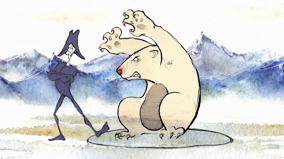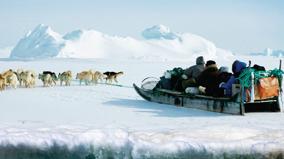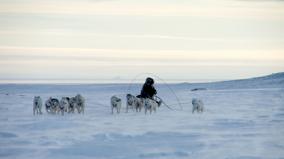Nunavut (Ages 18+)
Discover Nunavut—from its big cities and rural areas to its small towns and remote communities—through a selection of films that shines a spotlight on the province’s hidden treasures and fascinating characters. Suitable for both primary and secondary level students, this playlist includes animated and documentary films. These seminal works from our collection address the topics that matter most, ranging from historical subjects to the most pressing issues of the day.

Discover Nunavut—from its big cities and rural areas to its small towns and remote communities—through a selection of films that shines a spotlight on the province’s hidden treasures and fascinating characters. Suitable for both primary and secondary level students, this playlist includes animated and documentary films. These seminal works from our collection address the topics that matter most, ranging from historical subjects to the most pressing issues of the day.
Playlist
-
 Angry InukAlethea Arnaquq-Baril 2016 1 h 22 min
Angry InukAlethea Arnaquq-Baril 2016 1 h 22 minIn her award-winning documentary, director Alethea Arnaquq-Baril joins a new tech-savvy generation of Inuit as they campaign to challenge long-established perceptions of seal hunting. Armed with social media and their own sense of humour and justice, this group is bringing its own voice into the conversation and presenting themselves to the world as a modern people in dire need of a sustainable economy.
-
 Martha of the North (Short Version)Marquise Lepage 2008 47 min
Martha of the North (Short Version)Marquise Lepage 2008 47 minMartha was only 5 when she and her parents were lured away from their Inuit village. Along with a handful of other families, they were moved to Canada’s most northerly island, Ellesmere, to ensure Canadian sovereignty in the Arctic. They were told that game would be plentiful and life would be easy. Instead, they discovered that the islands of the Arctic are among the least hospitable to human life in the world. For years, they endured hunger and extreme cold. Deprived of the right to an education and a childhood, Martha had to help her family survive. Yet she proved as resilient as the other people from her community who appear in the film. Martha of the North is the story of a journey and a childhood spent in a new and unwelcoming land.
-
 Nowhere LandRosie Bonnie Ammaaq 2015 14 min
Nowhere LandRosie Bonnie Ammaaq 2015 14 minThis short documentary serves as a quiet elegy for a way of life, which exists now only in the memories of those who experienced it. Bonnie Ammaaq and her family remember it vividly. When Bonnie was a little girl, her parents packed up their essentials, bundled her and her younger brother onto a long, fur-lined sled and left the government-manufactured community of Igloolik to live off the land, as had generations of Inuit before them.
-
 This LandDianne Whelan 2009 35 min
This LandDianne Whelan 2009 35 minThis short documentary recounts a 2000-km expedition undertaken by 7 rangers (both Inuit and non-Native) and a female filmmaker to raise a flag on the northernmost tip of Canadian soil, 412 km from the North Pole. With a mesmerizing soundtrack by Nunavut-born singer Tanya Tagaq and spectacular footage of the Arctic landscape, This Land captures the epic adventure with raw immediacy.
-
 Never Lose SightSarah McNair-Landry 2009 21 min
Never Lose SightSarah McNair-Landry 2009 21 minThis short documentary presents the environmental challenges in Nunavut. Beneath the immaculate layer of snow, there are mountains of trash. Iqaluit's 2 dumps are filled beyond capacity and the municipality has no plan to solve the problem. Throughout the film, we discover the problems faced by this isolated region and learn just how serious they are. But above all, we hear a call to action from the residents, who don't want to see the North they love disappear. In French with English subtitles.
-
 Stories from Our Land Vol. 2 - Finding HomeNyla Innuksuk 2013 9 min
Stories from Our Land Vol. 2 - Finding HomeNyla Innuksuk 2013 9 minThis short film chronicles filmmaker Nyla Innuksuk's emotional journey to Nunavut to connect with the land of her ancestors and with her Inuk father, whom she has not seen in over 20 years. Nyla's return to her Igloolik birthplace culminates with a lesson on lighting a qulliq, the traditional Inuit oil lamp.
Stories from Our Land 2.0 is the latest edition of the NFB's Indigenous short film inititiative. This edition helped four Inuit youth hone the creative skills and tell their stories, offering viewers insightful perspectives on life in Nunavut. -
 Vanishing PointStephen A. Smith & Julia Szucs 2012 1 h 22 min
Vanishing PointStephen A. Smith & Julia Szucs 2012 1 h 22 minThis feature documentary tells the story of 2 Inuit communities of the circumpolar north—one on Canada’s Baffin Island, the other in Northwest Greenland—that are linked by a migration led by an intrepid shaman. Navarana, an Inughuit elder and descendant of the shaman, draws inspiration and hope from the ties that still bind the 2 communities to face the consequences of rapid social and environmental change.
-
 Animation from Cape Dorset1973 18 min
Animation from Cape Dorset1973 18 minReleased in 1973, this collection assembles the first animated films to be made by Inuit artists at the NFB. Featured is work by Solomonie Pootoogook, Timmun Alariaq, Mathew Joanasie, and Itee Pootoogook Pilaloosie—all participants in the Kinngait (formerly Cape Dorset) Film Animation Workshop on Baffin Island, established to teach animation skills to local artists. The soundtrack features performances by Aggeok and Peter Pitseolok. Commentary is provided in a blend of Inuktitut and English.
-
 Like Andrew QappikJane Churchill 2005 11 min
Like Andrew QappikJane Churchill 2005 11 minThis short documentary is a portrait of Andrew Qappik, a world-renowned Inuit printmaker from Pangnirtung, Nunavut. Originally inspired by images in the comic books he read as a child, Andrew now finds his subjects in the stories, traditions and day-to-day events of his world.
In I Can Make Art Like Andrew Qappik, he captivates his student audience by creating a soapstone relief print before their very eyes. Then it's the kids' turn. They explore Andrew's symbolic imagery - and their own - as they each create a self-portrait relief point. -
 MeltdownCarrie Mombourquette 2012 1 min
MeltdownCarrie Mombourquette 2012 1 minIn this short animation, a polar bear must try his luck finding a job in the big city when the last of his Arctic ice environment disappears. It’s hard fitting into the human world, however, so this bear finds a more creative solution to his predicament.
-
 PangnirtungJohn Feeney 1959 29 min
PangnirtungJohn Feeney 1959 29 minVisit the outpost community of Pangnirtung, located on the rim of the Arctic Circle, in this short documentary from 1959. Here, a handful of people provide for the health and welfare of a scattered Inuit population. The outpost, made up of nothing more than a cluster of buildings on a windswept fjord, has an influence that reaches far beyond its physical borders.
Please note that this is an archival film that makes use of the word “Eskimo,” an outdated and offensive term. While the origin of the word is a matter of some contention, it is no longer used in Canada. The term was formally rejected by the Inuit Circumpolar Council in 1980 and has subsequently not been in use at the NFB for decades. This film is therefore a time-capsule of a bygone era, presented in its original version. The NFB apologizes for the offence caused. -
 Arctic DefendersJohn Walker 2013 1 h 30 min
Arctic DefendersJohn Walker 2013 1 h 30 minSet in the dramatic and alluring landscape of the north, Arctic Defenders tells the remarkable story that began in1968 with a radical Inuit movement that changed the political landscape forever. It lead to the largest land claim in western civilization, orchestrated by young visionary Inuit with a dream - the governance of their territory - the creation of Nunavut. The story reveals Canada’s misguided attempts at sovereignty in the north and finds hope and inspiration from determined people who changed the rules of the game.
-
 Qimmit: A Clash of Two TruthsOle Gjerstad & Joelie Sanguya 2010 1 h 8 min
Qimmit: A Clash of Two TruthsOle Gjerstad & Joelie Sanguya 2010 1 h 8 minThis feature documentary offers an overview of the changes experienced by the Inuit from 1950-1970 with their loss of sled dogs and semi-nomadic lifestyle. A controversial issue at the time, many Inuit still believe that their dogs were deliberately killed by the RCMP as part of government policy to force them off the land and into "civilization." Qimmit: A Clash of Two Truths explores how and why the sled dogs disappeared, a mystery that has left deep wounds across Canada's Arctic.















